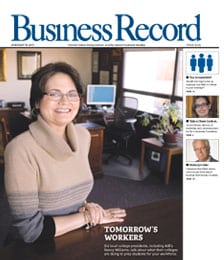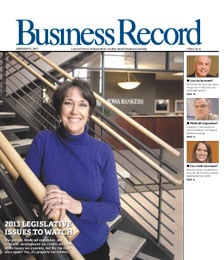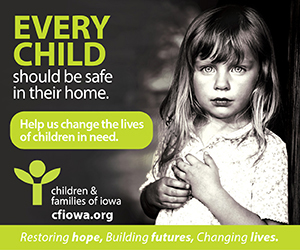Federal Home Loan Bank of Des Moines fuels home loan market

With $49 billion in assets, the Federal Home Loan Bank of Des Moines is larger than any Iowa-based bank. Yet it has no deposits and doesn’t lend to individuals or businesses.
Collectively owned by its 1,243 member financial institutions across Iowa, Missouri, Minnesota, South Dakota and North Dakota, the Des Moines-based wholesale bank plays a key behind-the-scenes role in making mortgage funds readily available to home buyers in its five-state region.
In just the past decade, the Des Moines-based institution has doubled in asset size, a reflection of both the burgeoning residential housing market and the expanded role the FHLB has played as federal regulations have reshaped its scope of business.
Of the 12 regional home loan banks, the Des Moines bank is the largest in terms of number of member banks.
“The vast majority of our members, probably 90 percent, are very small financial institutions,” said Nicky Schissel, the Des Moines FHLB’s vice president of communications and public affairs. “That’s been the real substance of our growth. Those small community financial institutions can’t go to Wall Street and issue debt and do the kinds of things that larger financial institutions do; it’s too expensive for them. So we’re a very primary resource for them.”
Flexible partner
The Federal Home Loan Bank of Des Moines has outstanding advances of approximately $27 billion to its member institutions, which in addition to banks include savings and loans, credit unions and insurance companies. The bank’s 386 Iowa members account for the largest share of its advances in those advances, with more than $8 billion loaned within the state. Members can borrow as terms as short as overnight to as long as 30 years, depending on their needs.
“It just depends on how it fits their business plan,” Schissel said. “One of the best things about the Home Loan Bank system is that we do have that flexibility. If you’re Bank A, you can come to us and explain how you’re doing business, and we can generally match an advance to fit what you need.”
The Federal Home Loan Bank of Des Moines is also heavily involved in affordable housing programs in its five-state district. In the past 15 years, the bank has awarded more than $103 million in competitive grants toward 818 affordable housing units. It also provides “community investment advances” to banks to assist the development of affordable housing projects for lower-income families, with more than $3.2 billion advanced to its members for these type of projects since 1990. Additionally, it launched a Rural Homeownership Fund in 1996 that has allocated $11.2 million for a program that provides money for first-time homebuyers in rural communities.
The bank’s net interest income, which is made up of the profit it makes from the spread between its cost of borrowing and earnings on advances plus its earnings on capital, was $26.8 million in the third quarter, down from $35.4 million in the third quarter of 2003. One of the reasons for the decrease, according to the quarterly report, was a strategic decision to lower profit margins to provide members more favorable rates on advances.
The pace of the FHLB’s business as interest rates rise will largely depend on the type of mortgages its members sell, Schissel said.
“It used to be that when rates went up, we actually increased our business because we had low-cost money and members were more likely to come to us,” she said. “Now, it depends more on the kinds of mortgages our members are doing. If they’re doing long-term fixed rates, they may sell those and not need as much to cover to them, but if they’re more adjustable rate mortgages, then they’re probably going to need more funding to cover them.”
A changing environment
Established in 1932 to provide mortgage funds to savings and loan associations, the Federal Home Loan Banks raise money by selling high-quality bonds on the international market. In 1989, Congress allowed commercial banks to become members for the first time, which greatly expanded the banks’ scope of operations.
Eight years ago, the rules were changed to allow the Federal Home Loan Banks to purchase mortgages from banks, which put them in competition with their publicly-held cousins, Fannie Mae and Freddie Mac, in the secondary mortgage market. At the end of 2004, the Des Moines bank had a mortgage portfolio of $15 billion. Nationally, eight other FHLBs participate with Des Moines in the Mortgage Partnership Finance Program, which has funded more than $137 billion of mortgages since 1997, providing a secondary market for nearly 900,000 loans.
Are Freddie and Fannie concerned about the competition?
“Let’s just say they’ve noticed,” Schissel said. “But we’re so small and new in the business, I don’t think they have any great concern about it.”
The Des Moines FHLB now has about 120 member institutions active in the mortgage purchase program, about twice as many as a year ago, Schissel said.
“It’s an involved process to get our customers signed up and active in the program,” she said. “Some of our banks are very small, and are not interested in that kind of mortgage program. So we’re working with the ones that are more active in mortgage lending.”
In light of the accounting irregularities uncovered at Fannie Mae in September, Congress is now considering legislation that would provide additional oversight over each of the government-sponsored entities — Fannie Mae, Freddie Mac and the Federal Home Loan Bank system.
However, “we don’t foresee a great many changes for the Federal Home Loan Bank system, because our regulator currently has some of the authority of this legislation,” Schissel said. “It will probably affect Fannie and Freddie much more than us.”







